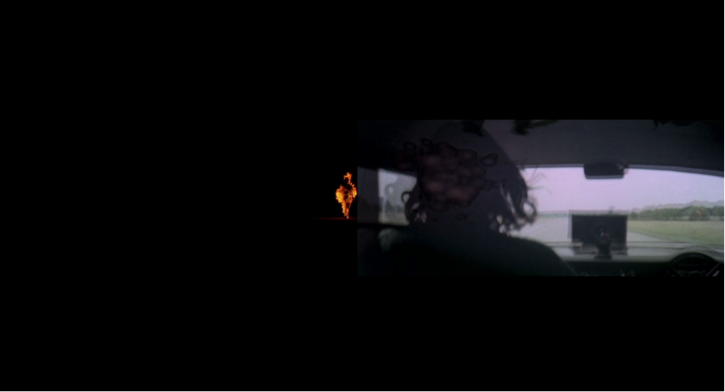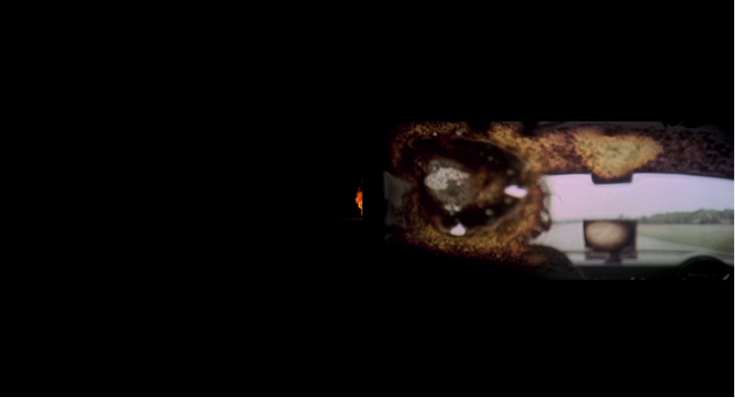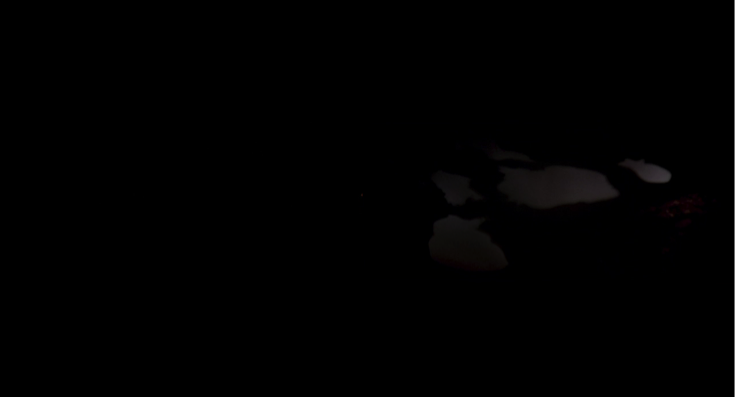Covadonga G. Lahera, INFLAMES. Originally published as ‘Electroma / Carretera asfaltada en dos direcciones‘, Transit. Cine y otros desvíos, July 2, 2009. Online at: http://cinentransit.com/electroma-carretera-asfaltada-en-dos-direcciones/
When I saw Electroma (Thomas Bangalter, Guy-Manuel De Homem-Christo, 2006) for the first time, and specifically when I saw the end of that film, in which one of the protagonists traverses the screen, completely on fire, in a slow motion downwards semicircle from left to right, I was immediately reminded of the climax to Two-Lane Blacktop, Monte Hellman’s 1971 iconic road movie, with its final, slowed vision of celluloid bursting into flames. The sudden combustion of that film’s last frames also suggested the burning up in the image of ‘the driver’, the young co-star who, up until that moment, had shared with his partenaire, ‘the mechanic’, a life seeking out people to race against in his Chevy 150.
The origin of this association was that simple: Hellman’s film came up and met the one and only feature film by Daft Punk, and that mental image is what I subsequently tried to bring into the timeline of a video editing program. In this way the two sequences could have a real, material encounter, and could accompany one another in their shared dematerialisation, simultaneously harboring the possibility of a new story, perhaps in some enclave of Route 66, or somewhere in the state of California, their only matching location. This would be a quiet crossing, like the one that had taken place in my head, hence the silencing of I Want to Be Alone (also known as Dialogue) that Jackson C. Frank plays over the closing scene of Electroma; the end of Two-Lane … had already dispensed with sound, its final frames halted by burning. My intention to make the scenes accompany one another, to make them rub up against each other, involved a second act of manipulation: to slow down the 35 second long sequence from Hellman’s film until it matched the 3’05” duration of the fragment from Electroma.
As I reflected later, linking the two films in this way really wasn’t so random, indeed, it was more than justified. Both belong to the quintessential journey film genre, the road movie, in its definition of a particular physical journey and his existentialist draft. Both opt for a minimalist mise-en-scene and feature a pair of friends who do not say much to one another (in the case of Electroma, remember that it’s a mute film–not a silent one–starring Hero Robot No. 1 and Hero Robot No. 2, who commence the film aboard a Ferrari 412 with the registration CALIFORNIA HUMAN). At the time of their release, the two films generated mixed reviews, however, over the years they have ascended the cult film podium, each with its own intense and surprising musical footprint. It should be noted, though, that even though both films came from filmed concerts, Thomas Bangalter and Guy-Manuel De Homem-Christo set aside their usual band name–Daft Punk–and along with it the temptation to include their own music in the soundtrack. The nine songs that we hear are by other artists (Brian Eno, Jackson C. Frank, classics like Chopin and Haydn …). Similarly, in Two-Lane Blacktop, with its songs by The Doors, Chuck Berry, Arlo Guthrie and Kris Kristofferson, music by its protagonists (the singer-songwriter James Taylor and the failed drummer of The Beach Boys Dennis Wilson) didn’t make it into the soundtrack
In the end, the meeting of the two sequences was made possible by a simple split screen device. It was the first time I edited a video-essay, my first Exposed Cinema feature. In actual fact, it was the first I had a go at any sort of editing. The spark that had caught fire in my head met these two blazing fragments, and suddenly it was as if the golden robot of Electroma, after witnessing his partner’s suicide and himself catching fire – using the rays of the sun magnified by a piece of glass from his cracked helmet – were to have succeeded in a final gesture of igniting the cellulose acetate of Two-Lane Blacktop also… So one could also think the images in this way. This experiment and game, which had been to rub two independent blocks of film together, re-contextualized them in a relationship with one another as road movies and as narratives of a particular odyssey whose drifter characters keep moving with their eyes on the horizon (one on foot, the other at the steering wheel). The End, in both films, catches them both en route, in the middle of the action, on the move, and overexposure (whether to sunlight or to projection mapping) will provide the reason for their extinction. Ashes to ashes, and fade to black.
© Covadonga G. Lahera, September, 2014
Translated and edited by Catherine Grant
Biographical note
Covadonga G. Lahera is a film critic and journalist. She is the co-founder and co-editor of the Spanish film website Transit: Cine y otros desvíos. She has contributed to Blogs and Docs, Caimán Cuadernos de Cine, Diario de Levante, LOLA, Gobshite Quarterly, La Furia Umana, Contrapicado, Lumière, Asiared. She has trained as a video editor and has edited audiovisual essays as well as a number of music videos and short films. She took part in the professional encounter “New media, new critic” at (S8), 5ª Mostra de Cinema Periférico de La Coruña, and was part of the first FIPRESCI jury at the Seville European Film Festival (SEFF). She is a committee member of the Catalan Association of Critics and Cinema Writers (ACCEC).




